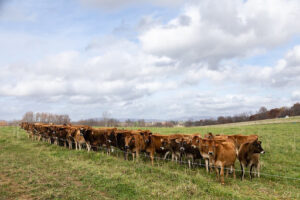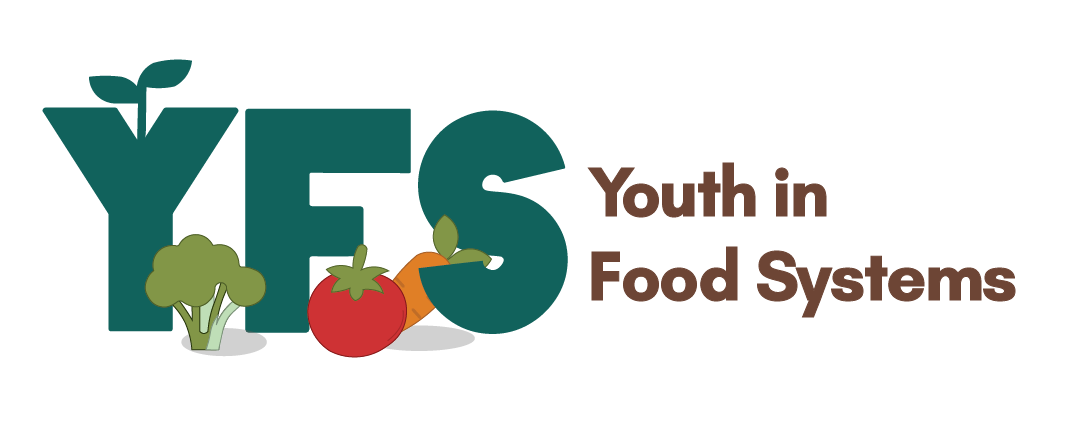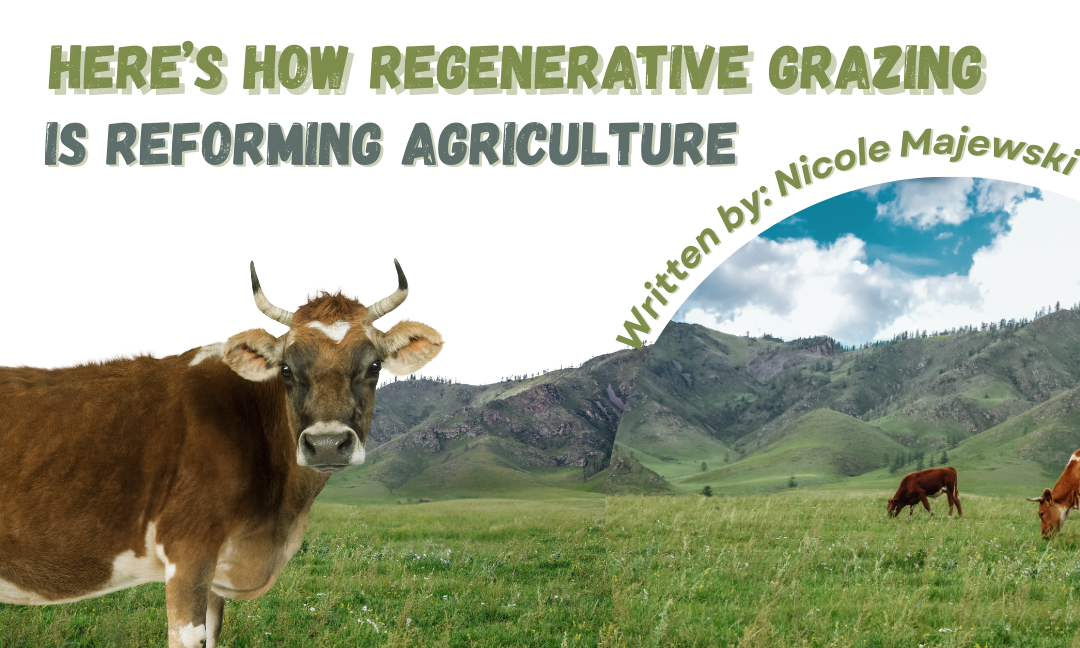Written by: Nicole Majewski
Edited by: Rayna Almas
Designed by: Andria Sahar
Published by: Rayna Almas
What is Regenerative Grazing?
Regenerative grazing is a more sustainable way to raise livestock like cows, sheep, and goats. Instead of letting animals graze the same patch of land over long periods of time, this method involves alternating their focus between smaller sections of pasture. Once the animals leave that portion of land, it’s left temporarily uninterrupted, giving it the time to recover that traditional grazing has unknowingly been denying.
Sometimes called rotational or holistic grazing, this approach centers around caring for the land as much as the livestock.

Why is Regenerative Grazing Important?
Many of us have heard the phrase, “take care of land, and it will take care of you”. This is the core component of regenerative grazing; by working in symbiosis with the needs of the environment, farming not only becomes less harmful to the world, but also more beneficial to us. With regenerative grazing, rather than exhausting one section of land, livestock is strategically rotated through multiple smaller pastures. By preventing the livestock from remaining in one place for too long, it opens up periods of time where there are no animals there. This rest period allows each of those individual land segments to regrow before animals return to graze once more.
Compared to traditional grazing practices, regenerative grazing is much more sustainable. Over time, it has been proven to prevent overgrazing—where livestock consume plants faster than they can grow back—and soil stress. Apart from its long-term benefits, though, regenerative grazing is also becoming increasingly important right now. Here’s why:
- It’s better for the animals. This lifestyle reduces stress and disease in livestock, and provides them with a more nutritional diet via a more diverse range of foliage. In fact, some cattle have reportedly gained thirty percent more weight just by grazing regeneratively rather than traditionally!
- It revives the land. When animals feed on the plants from one portion of land for too long, organic matter gets broken down. This disrupts the microbacterial populations that rely on that crucial part of soil. And since these bacteria in turn support vegetation, overgrazing ultimately makes it harder for the plants to grow back. However, rest periods prevent these disturbances and allow degraded soil to regain its nutrients. That’s not all, though; the periods between rest periods are good, too! When livestock move on to a new pasture, their hooves press beneficial nutrients from plant waste and manure into the soil. This ultimately recycles beneficial substances, which microbacteria can use to keep the soil healthy.
- It fosters biodiversity. Letting the land rest prevents extinction—and of course, a greater variety of insect and plant species in turn support an abundance of other life.
- It prevents droughts. Healthy soil holds water much better than dry, overworked land, and it’s also less prone to soil erosion. These factors mean that, the more we care for the soil, the more it’ll be able to take care of our structures.
- It fights climate change. Regenerative grazing actually does this in two ways. Firstly, it significantly reduces the amount of agricultural chemicals that farmers use. By frequently changing the location where livestock is grazing, there’s less reason to input large amounts of pesticides and fertiliser into the soil. Think about it; if the soil is only temporary, why “invest” in it? This not only increases farm profitability—with some Albertan farms reporting a shocking fifty percent reduction in fertiliser costs—but also reduces the risk of dangerous chemicals leaking into local ecosystems. Secondly, regenerative grazing creates soil that is better able to sequester carbon. While continuous grazing releases carbon into the atmosphere, regenerative grazing removes carbon. More specifically, it can sequester anywhere from two to twelve tonnes of carbon per hectare every year, a number that groups this practice into the same environment-saving category as forests and oceans.
What’s the Catch?
Regenerative grazing seems to offer solutions to many of the problems that come with farming. However, there are some challenges associated with it that are preventing many farmers from switching to this method:
- It can be costly to set up: Regenerative grazing requires a specific setup, including paddocks and more fencing. This can require a significant financial investment that may not be realistic for all farmers.
- It requires more work: Farmers need to take on many new tasks, like managing water systems, tracking animal movements, and keeping track of precise rotation schedules. For many family-run farms without a lot of employees, this extra labour demand could seem daunting.
- It needs more land: Having many smaller stretches of land often equates to a greater area than one large field does. So, on smaller farms, there might not be enough space available to implement regenerative grazing on a large scale.
What’s Next for Regenerative Grazing?
Luckily, many initiatives are being carried out to make regenerative grazing more accessible and effective. Costs are being reduced with alternatives like mobile fencing rather than permanent fencing, and solar-powered water systems rather than traditional ones. Workloads are being reduced with schedule-automating tools like drone imagery and specialised apps, which help track when the land needs a rest and when it’s ready for animals again. And importantly, mentorship is becoming more widely offered to farmers in order to support their transitions to this practice.
Looking ahead, regenerative grazing is likely to become more technology-based. Since this type of grazing is deeply based in data—relying on things like timing and careful land management—, there’s a lot of potential for artificial intelligence, drones, sensors, and satellite imagery to take over that work.
What’s even cooler, though, is recent research. Many studies suggest that we can improve land health even more by grazing multiple animal species together. For example, cattle and sheep have been shown to graze and travel in ways that complement each other, which could spread their benefits across more land.
Overall, regenerative grazing is an entirely new way of thinking about how we interact with the land. It has the potential to make farms more productive, animals healthier, and the planet better cared for. With more awareness, better tools, and continued research, this practice could become the new standard in farming; one that puts nature and agriculture back in balance.
References
The Farming Insider. (n.d.). Small livestock management for rotational grazing and pasture health. https://thefarminginsider.com/small-livestock-management-for-rotational-grazing-and-pasture-health/
Farmonaut. (n.d.). Unleashing the power of rotational grazing: Boosting productivity and carbon storage in Alberta’s grasslands. https://farmonaut.com/canada/unleashing-the-power-of-rotational-grazing-boosting-productivity-and-carbon-storage-in-albertas-grasslands
The Ranching Guide. (n.d.). Keep it growing: Monitoring pasture health in rotational grazing. https://theranchingguide.com/keep-it-growing-monitoring-pasture-health-in-rotational-grazing
DataCalculus. (n.d.). Implementing rotational grazing systems: A guide for pasture managers. https://datacalculus.com/en/blog/ranching/pasture-manager/implementing-rotational-grazing-systems-a-guide-for-pasture-managers
Organic Agriculture Centre of Canada. (n.d.). These grazing methods are rebuilding Alberta’s soil and farmer profits. https://organicagcentre.ca/soil-health-and-carbon-management/regenerative-agriculture-practices/these-grazing-methods-are-rebuilding-albertas‑soil-and‑farmer‑profits‑2
Williams, T. (2023, April 18). These cattle farmers are cutting emissions and boosting nature. TIME. https://time.com/6835547/regenerative-cattle-farming/
MAIA Grazing. (2024). Regenerative ranching benefits. https://www.maiagrazing.com/en-us/blog/regenerative-ranching-benefits
Canadian Cattlemen’s Association. (2020, September 29). What is regenerative grazing. https://www.canadiancattlemen.ca/from-the-ground-up/what-is-regenerative-grazing
Ecowatch. (n.d.). Regenerative grazing facts. https://www.ecowatch.com/regenerative-grazing-facts-ecowatch.html
Farmstand App. (n.d.). 7 key differences traditional vs regenerative grazing. https://www.farmstandapp.com/59460/7-key-differences-traditional-vs-regenerative-grazing
Barn Owl Tech. (n.d.). Regenerative grazing: What is it and what are the pros and cons? https://www.barnowl.tech/blogs/barn-owl-blog/regenerative-grazing-what-is-it-and-what-are-the-pros-and-cons
California State University, Chico – Center for Regenerative Agriculture and Resilient Systems. (n.d.). Regenerative grazing systems. https://www.csuchico.edu/regenerativeagriculture/regen-ag-systems/regen-grazing-systems.shtml
Image References
Chesapeake Bay Program. (n.d.). [Regenerative agriculture in Frederick County, Maryland] [Photograph]. Flickr. https://www.flickr.com/photos/chesbayprogram/52825574824

